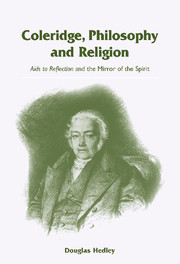Book contents
- Frontmatter
- Contents
- Acknowledgements
- List of abbreviations
- Notes on the text
- Prologue: explaining Coleridge's explanation
- 1 The true philosopher is the lover of God
- 2 Inner word: reflection as meditation
- 3 The image of God: reflection as imitating the divine spirit
- 4 God is truth: the faculty of reflection or human Understanding in relation to the divine Reason
- 5 The great instauration: reflection as the renewal of the soul
- 6 The vision of God: reflection culture, and the seed of a deiform nature
- Epilogue: the candle of the Lord and Coleridge's legacy
- Bibliography
- Index
Prologue: explaining Coleridge's explanation
Published online by Cambridge University Press: 15 December 2009
- Frontmatter
- Contents
- Acknowledgements
- List of abbreviations
- Notes on the text
- Prologue: explaining Coleridge's explanation
- 1 The true philosopher is the lover of God
- 2 Inner word: reflection as meditation
- 3 The image of God: reflection as imitating the divine spirit
- 4 God is truth: the faculty of reflection or human Understanding in relation to the divine Reason
- 5 The great instauration: reflection as the renewal of the soul
- 6 The vision of God: reflection culture, and the seed of a deiform nature
- Epilogue: the candle of the Lord and Coleridge's legacy
- Bibliography
- Index
Summary
And Coleridge, too, has lately taken wing,
But like a hawk, encumber'd with his hood,
Explaining metaphysics to the nation,
I wish he would explain his Explanation.
(Byron Don Juan)The Anglo-Saxons, namely, are naturally no more pure Empiricists than other people, and they have shown this clearly in their Renaissance poetry and their theological Platonism.
(Ernst Troeltsch)Coleridge, like some great river, the Orellana, or the St Lawrence, that had been checked and fretted by the rocks or thwarting islands, and suddenly recovers its volume of waters and mighty music, swept at once, as if returning to its natural business, into a continuous strain of eloquent dissertation, certainly the most novel, the most finely illustrated, and traversing the most spacious fields of thought, by transitions the most just and logical, that it was possible to conceive.
(Thomas de Quincey)S. T. Coleridge's seminal work Aids to Reflection was in part composed with the idea of countering the Cambridge ‘Atheism’ and ‘infidelity’ which seemed to have influenced his son Derwent, a student at St John's College (Aids, p. lxxiii). Coleridge visited Cambridge at the end of his life in 1833 to attend a conference of the British Association for the Advancement of Science, and he showed his friends Joseph Henry Green and Dr James Gillman his old undergraduate haunts. We shall argue that the Cambridge connection was of particular significance for Coleridge's thought. It was at Cambridge that the tradition of Locke was pre-eminent in the eighteenth century, especially through the figure of William Paley.
- Type
- Chapter
- Information
- Coleridge, Philosophy and ReligionAids to Reflection and the Mirror of the Spirit, pp. 1 - 17Publisher: Cambridge University PressPrint publication year: 2000



